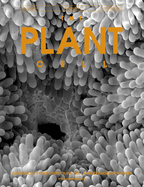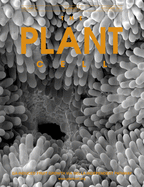
Cover image

GA-INDUCED FRUIT GROWTH VIA DELLA-INDEPENDENT PATHWAY
Fruit growth in Brassicacea species depends on fertilization of the gynoecium and subsequent hormonal activities. In Arabidopsis thaliana, the plant hormone gibberellin is required to degrade the growth-inhibiting DELLA proteins to induce fruit growth. The cover shows the stigmatic tissue of a Brassica rapa gynoecium where pollen will germinate and grow down the ovary to fertilize the ovules. Fuentes et al. (pages
Volume 24, Issue 10, October 2012
IN BRIEF
Pumping Iron: Conserved Iron Deficiency Responses in the Plant Lineage
Circadian Rhythms Require Proper RNA Splicing
In Silico Plant Biology Comes of Age
REVIEWS
Systems Analysis of Plant Functional, Transcriptional, Physical Interaction, and Metabolic Networks
Modeling Regulatory Networks to Understand Plant Development: Small Is Beautiful
Multiscale Systems Analysis of Root Growth and Development: Modeling Beyond the Network and Cellular Scales
Systems Analysis of Shoot Apical Meristem Growth and Development: Integrating Hormonal and Mechanical Signaling
LARGE-SCALE BIOLOGY ARTICLES
Systems and Trans-System Level Analysis Identifies Conserved Iron Deficiency Responses in the Plant Lineage
Transcriptomes of iron-limited versus -deficient Chlamydomonas reinhardtii cells under photoheterotrophic versus photoautotrophic conditions are described. Increased transcript abundance was positively correlated with protein abundance, except for iron-containing proteins where negative correlation was found. Some responses, including upregulation of MDAR1 and CGLD27/At5g67370, are conserved in land plants.
Conserved Noncoding Sequences Highlight Shared Components of Regulatory Networks in Dicotyledonous Plants
This study identifies regions of noncoding DNA in dicot plants that are likely to facilitate complex regulation of genes by binding multiple transcription factors. Regulatory mechanisms that the model organism Arabidopsis is likely to share with crop plants provide a focus for research that has real-world applications.
RESEARCH ARTICLES
Spatiotemporal Regulation of Lateral Root Organogenesis in Arabidopsis by Cytokinin
This work characterizes the role of cytokinins in lateral root organogenesis, finding that cytokinin activity is likely important to prevent lateral root initiation in close proximity to existing lateral root primordia. The results support the idea that stage-dependent effects of cytokinin are determined by the robustness of the auxin gradient, which might be enhanced in mature primordia.
Fruit Growth in Arabidopsis Occurs via DELLA-Dependent and DELLA-Independent Gibberellin Responses
This study shows that careful coordination of hormonal activities promotes fruit growth after fertilization in Arabidopsis thaliana. It identifies a previously unknown signaling pathway for the hormone gibberellin that may provide fine-tuning opportunities to ensure efficient reproduction. This pathway does not function through DELLA repressor proteins but instead involves the transcription factor SPATULA.
Arabidopsis bZIP16 Transcription Factor Integrates Light and Hormone Signaling Pathways to Regulate Early Seedling Development
This work identifies of bZIP16 as a transcriptional repressor regulating the expression of PIL5, RGL2, and genes influencing light, GA, and ABA signals. It indicates that bZIP16 is a newly identified G-box binding transcription factor integrating light and hormone pathways to promote seed germination and hypocotyl elongation during the early stages of Arabidopsis seedling development.
Arabidopsis MICROTUBULE DESTABILIZING PROTEIN40 Is Involved in Brassinosteroid Regulation of Hypocotyl Elongation
This study reveals a mechanism wherein brassinosteroids control the expression level of the microtubule-destabilizing protein MDP40 and regulate cortical microtubule organization to mediate hypocotyl cell elongation in Arabidopsis thaliana.
The Armadillo Repeat Gene ZAK IXIK Promotes Arabidopsis Early Embryo and Endosperm Development through a Distinctive Gametophytic Maternal Effect
Using a combination of genetic and expression analyses, this study reveals a reproductive function of the Armadillo repeat gene ZAK IXIK in promoting early embryo and endosperm development through a distinctive gametophytic maternal effect involving mechanisms for maternal allele-specific expression that are not implicated in the well-established pathways.
Characterization of a NADH-Dependent Glutamate Dehydrogenase Mutant of Arabidopsis Demonstrates the Key Role of this Enzyme in Root Carbon and Nitrogen Metabolism
A third isoenzyme of Glu dehydrogenase (GDH) is expressed in mitochondria of Arabidopsis root companion cells. A GDH triple mutant differed greatly from the wild type in continuous darkness, suggesting that the main function of the enzyme is to provide 2-oxoglutarate for the tricarboxylic acid cycle, leading to an accumulation of Ala, γ-aminobutyrate, and Asp in both roots and leaves.
Mutation of Arabidopsis SPLICEOSOMAL TIMEKEEPER LOCUS1 Causes Circadian Clock Defects
Arabidopsis encodes two STIP proteins (SPLICEOSOMAL TIMEKEEPER LOCUS 1/STIPL1 and STIP-LIKE 2/STIPL2) that share homology with human and yeast spliceosomal proteins. One or the other STIPL genes is required for seedling viability. stipl1 mutants have a long period circadian defect and accumulate alternately spliced transcript isoforms, whereas stipl2 plants do not have a circadian defect.
RETINOBLASTOMA RELATED1 Regulates Asymmetric Cell Divisions in Arabidopsis
Formative cell divisions produce daughter cells with different identities and are of key importance for the development of multicellular organisms. Here, formative divisions in the root and shoot of Arabidopsis are shown to be modulated by a common mechanism that relies on the activity level of a core cell cycle regulator that integrates cell proliferation with cell differentiation.
Spatiotemporal Asymmetry of the Meiotic Program Underlies the Predominantly Distal Distribution of Meiotic Crossovers in Barley
This work characterizes factors involved in the predominantly distal location of meiotic crossovers in barley. Recombination initiates first in the distal regions and later in the interstitial regions; manipulating meiotic progression with higher temperatures produced more interstitial crossovers that could improve mapping of agronomical traits and reduce linkage drag.
Agrobacterium May Delay Plant Nonhomologous End-Joining DNA Repair via XRCC4 to Favor T-DNA Integration
This work examines the role of a nonhomologous end-joining pathway gene, X-RAY CROSS COMPLEMENTATION GROUP4 (XRCC4), in T-DNA integration, finding that XRCC4 limits T-DNA integration and interacts directly with Agrobacterium VirE2 protein. These results suggest that Agrobacterium may modulate host DNA repair functions to increase T-DNA integration.
Nondisjunction in Favor of a Chromosome: The Mechanism of Rye B Chromosome Drive during Pollen Mitosis
This work examines the mechanism by which rye B chromosomes accumulate, finding that a combination of nondisjunction and unequal spindle formation at first pollen mitosis results in the accumulation of Bs in the generative nucleus and therefore ensures their transmission at a higher than expected rate to the next generation.
The DUF59 Family Gene AE7 Acts in the Cytosolic Iron-Sulfur Cluster Assembly Pathway to Maintain Nuclear Genome Integrity in Arabidopsis
This work shows that the evolutionarily conserved DUF59 family gene AE7 encodes a central member of the cytosolic iron-sulfur cluster assembly pathway and demonstrates that this pathway is required for maintaining nuclear genome integrity and, thus, normal mitotic cell cycle in Arabidopsis thaliana. The results link plant mitochondria to nuclear genome integrity through assembly of Fe-S proteins.
The Spectrum and Frequency of Self-Inflicted and Host Gene Mutations Produced by the Transposon Ac in Maize
When they move, transposons can cause mutations not only of host genes but also of themselves. This article reports that the maize (Zea mays) element Ac can mutate at a surprisingly high frequency on transposition and documents the several types of self-inflicted changes that it can undergo.
BASIC PENTACYSTEINE Proteins Mediate MADS Domain Complex Binding to the DNA for Tissue-Specific Expression of Target Genes in Arabidopsis
This article shows that regulation of the ovule identity gene STK is dependent on the binding of a MADS domain protein containing repressor complex to its promoter and that BPC binding sites are essential for the recruitment of this complex. It provides evidence that this is probably a general mechanism by which BPCs regulate gene expression in plants.
Structural Basis of Efficient Electron Transport between Photosynthetic Membrane Proteins and Plastocyanin in Spinach Revealed Using Nuclear Magnetic Resonance
This work investigates the residues of plastocyanin in close proximity to photosystem I and cytochrome b 6 f, in both the thylakoid vesicle–embedded and solubilized states. It demonstrates that electrostatic interactions are used to form a transient and loose contact of plastocyanin with photosystem I and cytochrome b 6 f, and then hydrophobic interactions are used to form electron transfer complexes of plastocyanin with photosystem I and cytochrome b 6 f.
The Arabidopsis Thylakoid ADP/ATP Carrier TAAC Has an Additional Role in Supplying Plastidic Phosphoadenosine 5′-Phosphosulfate to the Cytosol
This study shows that Arabidopsis thaliana TAAC is a plant PAPS transporter (PAPST1). Its functional characterization and the analysis of corresponding mutants demonstrate that TAAC/PAPST1 connects plastidic PAPS synthesis and cytosolic sulfation reactions. In contrast with the known animal PAPS antiporters that are members of the nucleotide-sugar transporter family, TAAC/PAPST1 belongs to the mitochondrial carrier family.
Spatio-Temporal Cellular Dynamics of the Arabidopsis Flagellin Receptor Reveal Activation Status-Dependent Endosomal Sorting
The immune receptor FLAGELLIN SENSING2 (FLS2) plays important roles in plant resistance to bacterial pathogens and is internalized from the plasma membrane via the endocytic pathway. Ligand-activated FLS2 traffics into late endosomal compartments, and this process requires the function of components distinct from nonactivated FLS2 that recycles between early endosomes and the plasma membrane.
Non-Recognition-of-BTH4, an Arabidopsis Mediator Subunit Homolog, Is Necessary for Development and Response to Salicylic Acid
This work identifies NONRECOGNITION OF BTH4 (NRB4), which acts in SA signaling in defense and development, finding that NRB4 encodes a predicted subunit of the Mediator complex, which connects specific transcription factors to the general transcription machinery. NRB4 functions downstream of NONEXPRESSER OF PATHOGENESIS-RELATED1in SA signaling.
Nonredundant Regulation of Rice Arbuscular Mycorrhizal Symbiosis by Two Members of the PHOSPHATE TRANSPORTER1 Gene Family
The arbuscule-specific expression of two rice PHOSPHATE TRANSPORTER1 (PHT1) genes, PT11 and PT13, suggests that both of these genes play a role in symbiotic phosphate acquisition. Indeed, they are both important for the development of arbuscular mycorrhizal symbioses in rice; however, PT11 is the key player in fungus-delivered phosphate uptake.
Bidirectional Secretions from Glandular Trichomes of Pyrethrum Enable Immunization of Seedlings
This work reveals that in addition to storing mono- and sesquiterpene compounds or emitting them into the headspace, trichomes can also secrete products into the intercellular space of sub-epidermal tissues. This secretion allows roles in tissues unable to produce such compounds themselves, for instance ultimately immunizing seedlings of the following generation against fungi and insects,
Arabidopsis Chloroplast RNA Binding Proteins CP31A and CP29A Associate with Large Transcript Pools and Confer Cold Stress Tolerance by Influencing Multiple Chloroplast RNA Processing Steps
This work examines the chloroplast ribonucleoproteins CP31A and CP29A by plastome-wide analysis of chloroplast RNA metabolism, finding that these proteins associate with a large set of chloroplast transcripts and are required for cold stress resistance, targeting multiple chloroplast mRNA processing steps.
Constitutively Active Mitogen-Activated Protein Kinase Versions Reveal Functions of Arabidopsis MPK4 in Pathogen Defense Signaling
Mutations generating constitutively active (CA) mitogen-activated protein kinases (MAPKs) were identified and used to investigate the role of Arabidopsis MPK4 in plant immunity, revealing functions of MPK4 activity in PTI and ETI, establishing that the generation of CA-MAPKs offers a powerful tool to analyze MAPK functions in plants.
The Arabidopsis Mediator Complex Subunit16 Positively Regulates Salicylate-Mediated Systemic Acquired Resistance and Jasmonate/Ethylene-Induced Defense Pathways
This article identifies a role for the Arabidopsis thaliana Mediator complex subunit MED16 in bridging between specific transcription activators and the transcriptional machinery in the activation of salicylic acid–responsive defenses, including defense gene transcription, pathogen resistance, and systemic acquired resistance. MED16 also participates in ethylene- and jasmonic acid–induced defenses.


